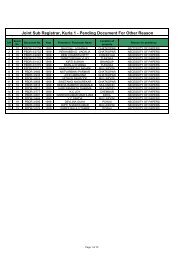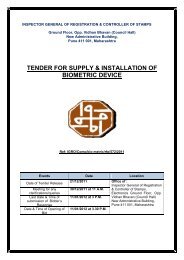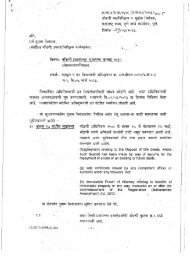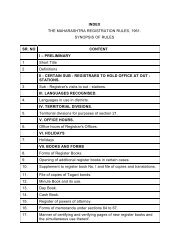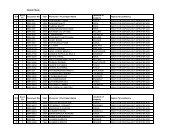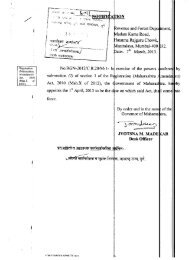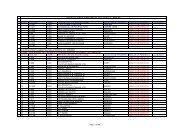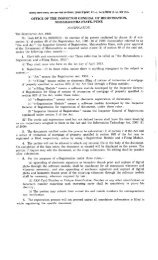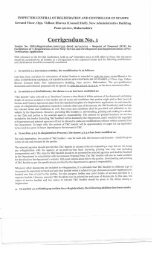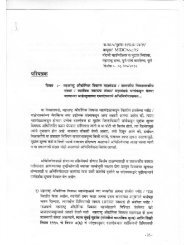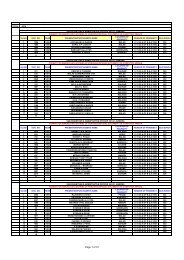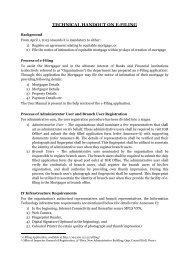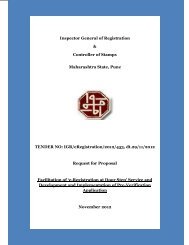THE BOMBAY STAMP ACT, 1958 - Igrmaharashtra.gov.in
THE BOMBAY STAMP ACT, 1958 - Igrmaharashtra.gov.in
THE BOMBAY STAMP ACT, 1958 - Igrmaharashtra.gov.in
You also want an ePaper? Increase the reach of your titles
YUMPU automatically turns print PDFs into web optimized ePapers that Google loves.
Constitutional Position –Law relate to stamps and stamp duties regard<strong>in</strong>g documents other than those specified <strong>in</strong> Entry 91of List I of Schedule VII of the Constitution, Specified documents are bills of exchangepromissory notes, bills of lad<strong>in</strong>g, letters of credit, policies of <strong>in</strong>surance, transfer of shares,debentures, proxies and receipts and the field related to rates of stamp duties. List II empowersstate to enact laws for rates of stamp duty <strong>in</strong> respect of documents other than specified <strong>in</strong> List I.Rates for stamp duties for specified documents <strong>in</strong> List I. Entry 91 can by prescribed byParliament and rates for stamp duties for other documents can be prescribed by State laws. Entry44List II empowers concurrently Parliament and State legislatures to make laws for stamp duties.Thus levy and charge of stamp duties can be imposed by both the Parliament and Statelegislatures subject to repugnancy and occupied field. Rates however have to be prescribedexclusively by Parliament for specified documents and by State legislatures <strong>in</strong> respect of otherdocuments.Thus the preamble <strong>in</strong>dicates that the Act prescribes rates of stamp duty and levies stampduties on documents as set out <strong>in</strong> the Act. Section 74 of the Act specifically excludes thedocuments as mentioned.Scheme of the Act-Section 3 is a charg<strong>in</strong>g section and provides for charg<strong>in</strong>g stamp duties on <strong>in</strong>strument andto that extend it levies duties on <strong>in</strong>strument and not on the transaction. The tax<strong>in</strong>g events is whenthe <strong>in</strong>strument is executed <strong>in</strong> the State for the first time without be<strong>in</strong>g previously executed.Document as def<strong>in</strong>ed <strong>in</strong> Evidence Act means any matter expressed or described upon substanceby means of letters, figures or marks or by more than one of those means <strong>in</strong>tended to be used orwhich may be used for the purpose of record<strong>in</strong>g that matter. Explanations to Section 62 of theEvidence makes each counterpart of a document to be primary evidence as mentioned and wheredocument is executed <strong>in</strong> several parts each part is primary evidence of the document. Section 4 ofthe Bombay stamp Act provides for specified documents executed <strong>in</strong> several parts and the dutieschargeable thereon. Here the dist<strong>in</strong>ction made is between pr<strong>in</strong>cipal <strong>in</strong>strument and other<strong>in</strong>struments Sub Section 4,5,6. Further duty is payable and has to be paid on the pr<strong>in</strong>cipal<strong>in</strong>strument and it is only when such duties are paid that other <strong>in</strong>struments can be received <strong>in</strong> thestate hav<strong>in</strong>g regard to Section7. Section 8 provides for special rates on certa<strong>in</strong> documents asmentioned.Sub-section 10 prescribes the mode of pay<strong>in</strong>g duties on <strong>in</strong>struments by user of stamps onsuch <strong>in</strong>struments. Sub-section 10 to 14 are mach<strong>in</strong>ery sections provid<strong>in</strong>g as to how the stamp dutyis to be collected. Section 15 provides that when stamp duties are not paid as provided for thenthe <strong>in</strong>strument shall be deemed to be not duly stamped. Sub-section 17 to 19 prescribes the timewhen stamp duty can be said to be duly paid. Events prescribed are two-(1) When the <strong>in</strong>strumentis executed <strong>in</strong> the state; (2) When the <strong>in</strong>strument though executed outside is brought <strong>in</strong>to theState.Sub-section 20 to 29 sets out as to how the <strong>in</strong>struments have be valued for the purposedof stamp duty. Sub-section 21 to 23, 25 prescribes how ad valorem stamp duties have to bevalued. Sub-section 24,26, 17 provides for the valuation is cases as mentioned there<strong>in</strong>.Section 28 prescribes that all matters must be mentioned <strong>in</strong> the <strong>in</strong>strument affectionchargeability to stamp duty.Section 29 provides for apportionment of duties regard<strong>in</strong>g separate parts of <strong>in</strong>strumentamong different persons.Section 30 provides for persons liable to pay the stamp duties.Chapter III SCHEDULE 31 TO 32 C provides for adjudication.



